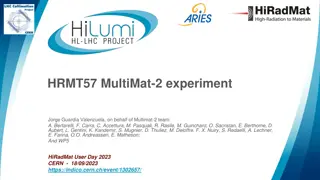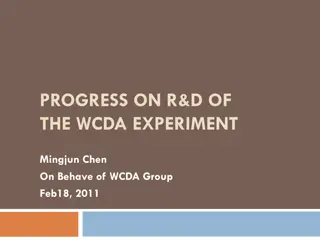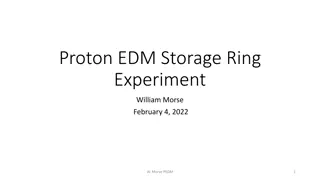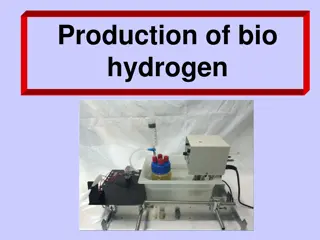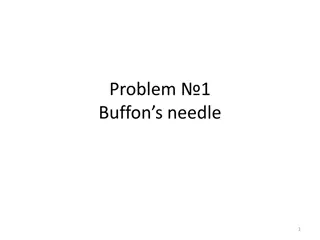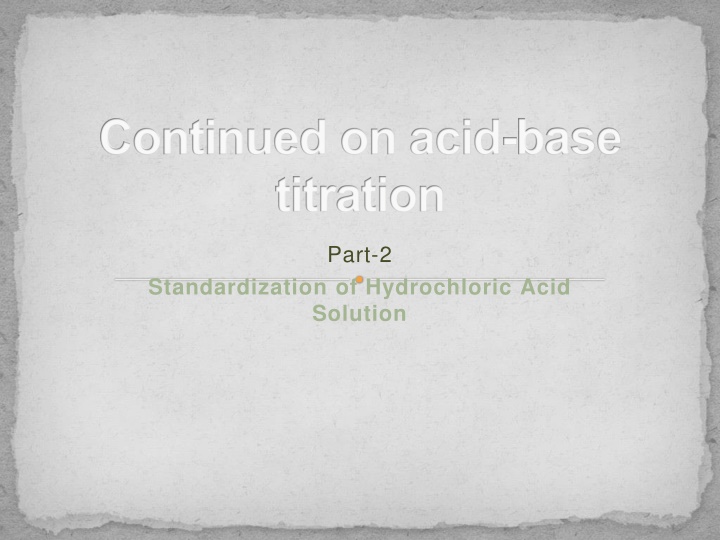
Acid-Base Titration Fundamentals
Learn about key concepts in acid-base titration, such as pH, pKa, equivalence point, endpoint, and normality. Understand how these terms relate to the standardization of solutions and the process of titration. Explore the significance of pH indicators and titration curves in chemical analysis.
Download Presentation

Please find below an Image/Link to download the presentation.
The content on the website is provided AS IS for your information and personal use only. It may not be sold, licensed, or shared on other websites without obtaining consent from the author. If you encounter any issues during the download, it is possible that the publisher has removed the file from their server.
You are allowed to download the files provided on this website for personal or commercial use, subject to the condition that they are used lawfully. All files are the property of their respective owners.
The content on the website is provided AS IS for your information and personal use only. It may not be sold, licensed, or shared on other websites without obtaining consent from the author.
E N D
Presentation Transcript
Continued on acid-base titration Part-2 Standardization of Hydrochloric Acid Solution
Terms used in titration - pH - Pka - Indicator - End point - Equivalent point - Units of concentrations - Titration curves
pH pH is a measure of hydrogen ion concentration; a measure of the acidity or alkalinity of a solution. Aqueous solutions at 25 C with a pH less than seven are acidic, while those with a pH greater than seven are basic or alkaline. A pH level of is 7.0 at 25 C is defined as 'neutral' because the concentration of H3O+ equals the concentration of OH in pure water.
pKaand Ka The Kavalue is a value used to describe the tendency of compounds or ions to dissociate. The Ka value is also called the dissociation constant, the ionization constant, and the acid constant. The definition of Kais: [H+].[B] / [HB], where B is the conjugate base of the acid HB. The pKavalue is defined from Ka, and can be calculated from the Kavalue from the equation pKa = -Log10(Ka)
The equivalence point Or stoichiometric point, of a chemical reaction is the point at which stoichiometrically equal to the number of moles of substance (known as analyte) present in the sample: the smallest amount of titrant that is sufficient to fully neutralize or react with the analyte. In some cases there are multiple equivalence points which are multiples of the first equivalent point, such as in the titration of a diprotic acid. an added titrant is
The endpoint /pH indicator: (related to, but not the same as the equivalence point) refers to the point at which the indicator changes color in a colorimetric titration. This is a substance that changes color in response to a chemical change. An phenolphthalein) changes color depending on the pH. Redox indicators are also frequently used. A drop of indicator solution is added to the titration at the start; when the color changes the endpoint has been reached, this is an approximation of the equivalence point. acid-base indicator (e.g.,
Normality Normality is another way of expressing the concentration of a solution. It is based on an alternate chemical unit of mass called the equivalent weight. The normality of a solution is the concentration expressed as the number of equivalent weights (equivalents) of solute per liter of solution. A 1 normal (1 N) solution contains 1 equivalent weight of solute per liter of solution. HCl(aq) + NaOH(aq) NaCl(aq) + H2O 1 mole 1 mole (36.5 grams) (40.0 grams)
Titration curves A titration curve provides us with a visual picture of how a property of the titration reactionchanges as we add the titrant to the titrand.
Acid base titration During an acid-base titration, the pH changes in a characteristic way. A pH curve is found if the pH of the solution being titrated is plotted against the volume of solution added.
The equivalence point, or stoichiometric point, corresponds to the mixing together of stoichio- metrically equivalent amounts of acid and base. Note that the pH at equivalence is not necessarily 7 (see table 1 below) The pH of a weak base at the end-point (equivalence) lies below pH 7. At equivalence, the solution contains the salt of a weak base: this is an acid (the conjugate acid of the weak base) and so the solution is acidic.
The pH of a weak acid at the end-point (equivalence) lies above pH 7. At equivalence, the solution contains the salt of a weak acid: this is a base (the conjugate base of the weak acid) and so the solution is basic.
Table1ThepHatthestart,equivalenceandtwiceequivalenceforvariouscombinationsTable1ThepHatthestart,equivalenceandtwiceequivalenceforvariouscombinations ofacidsasshowninthetitrationcurvesinfigures1and2.
Types of indicators A) Strong acid titrations: / base against strong base / acid Phenolphthalein / methyl orange and methyl red fall with in the range of the inflection of this group. B) Weak acid and strong base titration: phenolphthalein is a suitable indicator as its pH range is 8- 9.8. However, methyl orange is not suitable as its pH range is 3.1 to 4.5.
C) Weak base and strong acid titration: methyl orange is phenolphthalein is not suitable. a suitable indicator while
Procedure Reagents: 1- Hydrochloric Acid (Reagent Grade). 2- Phenolphthalein Indicator (0.5 g in 50 ml ETOH +50 ml H2O). 3- Standard NaOH Solution (0.1 M).
- Titration with Standard Base: 1- Rinse a buret 2 times with 5 ml portions of a standard 0.1 N NaOH solution then fill (from part A) and cover with a test tube. 2- Introduce (to the nearest 0.03 ml) approximately 25 ml of the HCL solution into each of the 250 ml Erlenmeyer flasks, touch the buret tip to the inside of the flask each time and rinse down with a few ml of water.
(Note: the number of meq of an acid will remain the same upon small additions of water). 3- Add two drops of phenolphthalein indicator to each sample just prior to titrating with standard base. 4- Titrate with the standard NaOH solution until the faintest pink tinge persists for at least 30 seconds. 5- Calculate the molarity of the HCL solution.
Calculation HCl(aq) + NaOH(aq) 1 mole NaCl(aq) + H2O 1 mole (36.5 grams) (40.0 grams) Meq HCL = Meq NaOH V (ml) HCL * M HCL = V (ml) NaOH * M NaOH M HCL = V (ml) NaOH * M NaOH /V (ml) HCL

